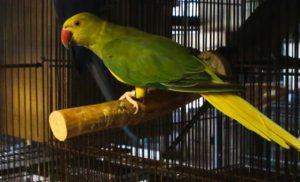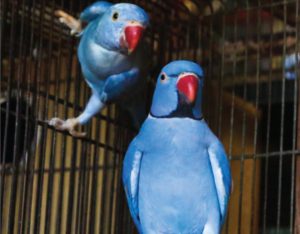Parakeets come in varying sizes and a dizzying array of colors, but for breeder Hansel Sy, none can compare to the majesty of the ringneck. Animal Scene sat down with Sy to learn some of the secrets of this animated avian.
MEET THE RINGNECK – The ringneck parakeet (Psittacula krameri) is native to parts of Asia and Africa, though enthusiasts all over the world breed them. There are four subspecies:
• Indian ringneck (P. k. manillensis), found in south India and Ceylon;
• African ringneck (P. k. krameri), found in western and central Africa in Guinea and Senegal;
• Neumann’s ringneck (P. k. borealis), found in West Pakistan, Northern India and Nepal; and
• Abyssinian ringneck (P. k. parvirostris), found in Ethiopia and Sudan.
Among these, it is the Indian ringneck that is best known and most generally available. It is about 16 inches in length, including its majestic tail feathers. According to petplace.com, “Ringnecks are highly intelligent and able to observe and learn behavior very easily. When taught carefully, ringnecks are able to learn to talk and their speaking ability can outrank that of the cockatiel or similar smaller birds.”
Sy says the lifespan of a ringneck is pretty long, and males and females have about the same life span, a maximum of around fourteen years.

He shares, “I have one ringneck, a male, that’s been with me for eight years. I don’t pair him often, but I think he is still capable of breeding because he’s still very healthy. He still flies around a lot.”
A HEALTHY APPETITE – Of course, such a life expectancy is helped by a proper diet. Sy reminds breeders and pet owners to be careful about the ringneck’s diet. He strongly advises against overfeeding or letting the birds become overweight. Similar to humans, he says, weight problems give them difficulty with breathing, and can lead to heart problems. “If they feel hot, or get stressed, they will have shortness of breath, and they will get weak. So proper diet is very important.”
What do you feed a ringneck? Sy recommends a diet full of vegetables and fruits almost as colorful as the ringneck’s plumage. “In the morning, give them vegetables, like okra, squash, carrots, kamote. Kamote is heavy and makes them full quickly. They like white corn, but you can also give them sweet corn for variety. If you give them leafy vegetables, make sure to chop these finely because it might get stuck in the throat or their internal organs, and they might have trouble breathing. The stems of pechay are okay, because they can bite that. They can also eat fruits like apples and peaches. Fruits and vegetables are really the best diet for them. What I do is, I give each bird a piece of corn and a slice of apple.”
Seeds are part of the diet too. “In the afternoon, that’s when I give them seeds, in a feeder so they can eat it anytime and they won’t go hungry. I give them sunflower seeds, and they can also have millet. You can also give them nuts, or imported feed, for variety. But vegetables are really best. They won’t gain too much weight, and they stay healthy.”
Older birds, like older humans, need to watch what they eat! Sy cautions, “At around eight to ten years old, don’t give them too many beans like sitaw, or fruits like peaches. Be careful with their diet. Like people, they also get arthritis, diabetes. Their feathers break off easily.”

Like humans, ringnecks also benefit from vitamin C. Sy explains, “Vitamin C is important given Philippine weather: it’s really hot, then it suddenly rains. The vitamin C should be in powder form, mixed with their water. Otherwise they might get acidic. Another option is vitamin C tablets. You can crush it and mix it with their food. Don’t give the tablet whole, because it’s very strong.”
SCRATCH THAT ITCH – As with most birds, insect bites and lice can be a problem. Sy recommends spraying them with anti-lice shampoo carefully, avoiding the eyes.
Some people prefer to hold the bird, and dip them slowly in the shampoo, which is in a small bucket or container. Sy says, “This also lets you rub the shampoo into and under their feathers. Just make sure not to get it on their heads. Then let them dry off in the sunshine.”
The ringneck is usually very lively, and likes moving around a lot. “If it’s quiet and doesn’t move around much, it might not be in good health,” Sy warns.
FLY, MY PRETTIES! – Sy explains that ringnecks need space, and recommends keeping them in a cage measuring at least 2 x 2 x 4 feet.
“It’s best to keep them in a cage where they can fly. The size of the cage really makes a big difference. A chick can learn to fly even while it’s small. If your cage is small, the birds just sit, and don’t really fly. They just crawl and walk around. If they can fly, the development of their muscles is better. They grow better.”
One advantage of keeping ringnecks is that you need few accessories or toys. “For most birds, you don’t need a fancy cage. But bigger is better. And you just need to make sure they’re comfortable, in an area where people don’t really bother them. That also makes it easier for them to pair.”
GO FORTH AND MULTIPLY – Of course, one main concern is when and how to breed the ringneck. Ringnecks come to maturity at one and a half years old. They can start courting at this stage, but usually this takes place at age one year and ten months. The female matures faster, at one and a half years, while males mature at one year and ten months. Females also go into heat earlier. Sy observes that courtship usually takes place early in the morning, at 3 to 4 AM.
Sy cautions, “If you have a younger male, and the female wants to breed already but the male doesn’t, watch them carefully. The female usually picks a fight with the male, so you might find them bleeding, because the male resisted the female. Sometimes they lose feathers and die. When that happens, separate the males.”

Once they start breeding, they keep going. Sy says, “Sometimes there’s no real breeding season. In my experience, sometimes they breed in the summer. Sometimes they breed in the fall. They like it when the weather is changing, especially when it’s warm, like here in the Philippines.”
LIKE AND LIKE – For breeders of the ringneck, the biggest concern is getting their desired color. But rather than forcing a pair of birds to breed, Sy suggests a breeding community. “Self-pairing is better.”
Bring a balanced number of males and females into your breeding cage, which should be over six feet tall, so the birds can fly. In this colony, bring together the colors you want to get, so it’s okay if they breed.
How do you get the color you want? As with all breeding, this remains a challenge, but Sy has some insights to share. “Breed colors that will go together for nice results. Green is very strong, so sometimes it’s hard to predict how the color will turn out. Turquoise-violet can be paired with normal violet or opal blue, or normal blue, and result will be turquoise with shades of the other color. Violet and emerald are the newest colors.”
The important thing to remember, Sy says, is that the male should be the one with the mutations, like the highly saleable harlequin, or the white head with white tail. It is through the male parent that these traits are passed on. “Mutations turn out really well with opal and violet, and the resulting colors are really good. If you breed green plus emerald, sometimes you get a split.”
BABY BIRDS – Once the birds produce young, Sy advises breeders to watch them carefully, because the females get stressed.
Sy shares, “When the chicks are only two weeks old, we take them away and hand-feed them, so the mother can rest, especially if it’s warm, because they feel uncomfortable. Sometimes if the chicks are only one week old, we have to take them away already. Sometimes the parents don’t feed the young, sometimes they just leave them alone or ignore them. When we separate them, there’s a better chance of both the parents and the chicks surviving, because there’s less stress.”
This is especially important if the birds were able to produce young in the desired color. “We watch out for the ones whose color we want to preserve. We separate them and we hand-feed them.”
As with all species, breeding, especially for such vast varieties and colors, can be tricky. But with words of wisdom from an award-winning master such as Sy, the challenge can be a little more manageable.
ADDITIONAL RESOURCES:
•http://www.petplace.com/article/birds/general/bird-profiles/choosing-a-ringneck-parakeet
INDIAN RINGNECK:
• http://birds.about.com/od/breedsofbirds/p/IndianRingnecks.htm
• http://indianringneck.com/
• http://www.birdtricks.com/indian-ringneck-parrot.html
• http://www.birdchannel.com/bird-species/find-the-right-bird/indian-ring-necked-parakeets.aspx\
AUSTRALIAN RINGNECK:
•https://www.beautyofbirds.com/australianringnecks.html
•https://www.beautyofbirds.com/australianringneckspecies.html
AFRICAN RINGNECK:
• http://parrotfeather.com/asiatics/africanringnecks/
This story appeared as “Radiant Ringneck: Secrets from a Master Breeder” in Animal Scene’s July 2016 issue.






